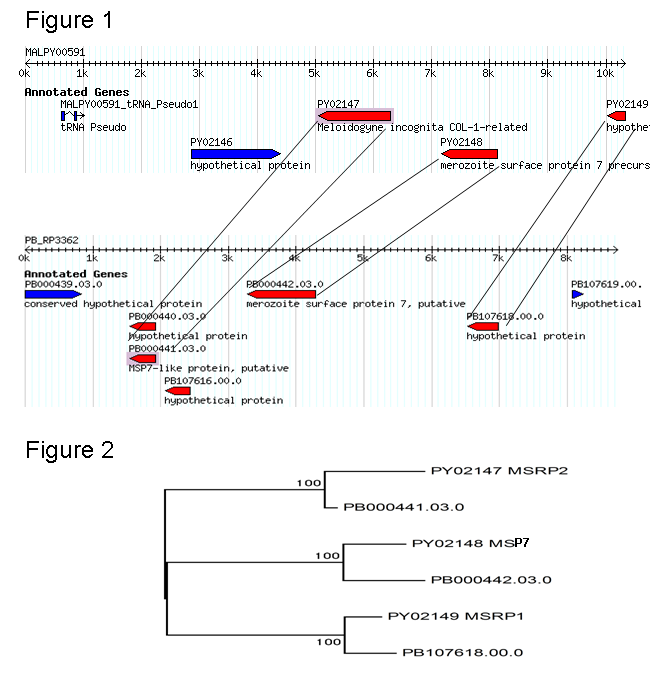SummaryRMgm-671
|
||||||||
 *RMgm-671
*RMgm-671| Successful modification | The parasite was generated by the genetic modification |
| The mutant contains the following genetic modification(s) | Gene disruption |
| Reference (PubMed-PMID number) |
Reference 1 (PMID number) : 21980474 |
| MR4 number | |
| top of page | |
| Parent parasite used to introduce the genetic modification | |
| Rodent Malaria Parasite | P. berghei |
| Parent strain/line | P. berghei ANKA |
| Name parent line/clone | Not applicable |
| Other information parent line | |
| top of page | |
| The mutant parasite was generated by | |
| Name PI/Researcher | N.D. Gómez; K. Haldar |
| Name Group/Department | Center for Rare and Neglected Diseases |
| Name Institute | University of Notre Dame |
| City | Notre Dame, Indiana |
| Country | USA |
| top of page | |
| Name of the mutant parasite | |
| RMgm number | RMgm-671 |
| Principal name | Δmsp7 |
| Alternative name | |
| Standardized name | |
| Is the mutant parasite cloned after genetic modification | Yes |
| top of page | |
| Phenotype | |
| Asexual blood stage | Mutant blood stages show a minor growth defect resulting in a lower growth rate in BALB/c mice during the initial phase of infection (day 8/10). At later stages of infection (when reticulocytes are prevalent), the growth rate was similar to that of wild type parasites. In aged WISTAR rats (15 weeks) the mutant blood stages showed a reduced growth and virulence phenotype. |
| Gametocyte/Gamete | Not tested |
| Fertilization and ookinete | Not tested |
| Oocyst | Not tested |
| Sporozoite | Not tested |
| Liver stage | Not tested |
| Additional remarks phenotype | Mutant/mutation Figure 1
|
 Disrupted: Mutant parasite with a disrupted gene
Disrupted: Mutant parasite with a disrupted gene| top of page | |||||||||||||||||||||||||
| Details of the target gene | |||||||||||||||||||||||||
| Gene Model of Rodent Parasite | PBANKA_1349100 | ||||||||||||||||||||||||
| Gene Model P. falciparum ortholog | PF3D7_1335100 | ||||||||||||||||||||||||
| Gene product | merozoite surface protein 7 | ||||||||||||||||||||||||
| Gene product: Alternative name | MSP7 | ||||||||||||||||||||||||
| top of page | |||||||||||||||||||||||||
| Details of the genetic modification | |||||||||||||||||||||||||
| Inducable system used | No | ||||||||||||||||||||||||
| Additional remarks inducable system | |||||||||||||||||||||||||
| Type of plasmid/construct used | Plasmid double cross-over | ||||||||||||||||||||||||
| PlasmoGEM (Sanger) construct/vector used | No | ||||||||||||||||||||||||
| Modified PlasmoGEM construct/vector used | No | ||||||||||||||||||||||||
| Plasmid/construct map | |||||||||||||||||||||||||
| Plasmid/construct sequence | |||||||||||||||||||||||||
| Restriction sites to linearize plasmid | |||||||||||||||||||||||||
| Partial or complete disruption of the gene | Partial | ||||||||||||||||||||||||
| Additional remarks partial/complete disruption | No sequence information of the target sequences is provided. No information is provided for the primers used to amplify the target regions for disruption of the msp7 gene homologous recombination. | ||||||||||||||||||||||||
| Selectable marker used to select the mutant parasite | tgdhfr | ||||||||||||||||||||||||
| Promoter of the selectable marker | pbdhfr | ||||||||||||||||||||||||
| Selection (positive) procedure | pyrimethamine | ||||||||||||||||||||||||
| Selection (negative) procedure | No | ||||||||||||||||||||||||
| Additional remarks genetic modification | The mutant was generated using plasmid pDHΔMSP7 as previously described in RMgm-224. No sequence information of the target sequences is provided. No information is provided for the primers used to amplify the target regions for disruption of the msp7 gene homologous recombination. | ||||||||||||||||||||||||
| Additional remarks selection procedure | |||||||||||||||||||||||||
|
Primer information: Primers used for amplification of the target sequences
 Primer information: Primers used for amplification of the target sequences

| |||||||||||||||||||||||||
| top of page | |||||||||||||||||||||||||

